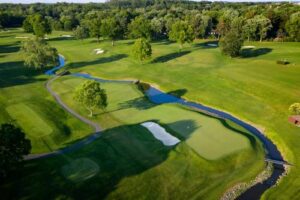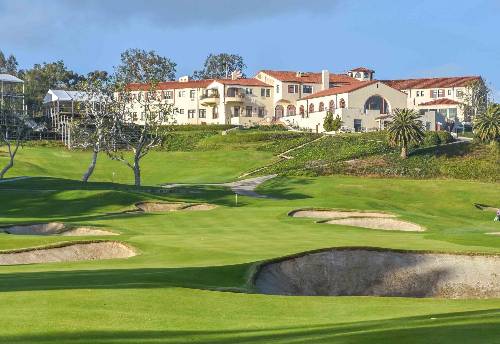
Los Angeles Has Returned to the U.S. Open Rotation, but for How Long at L.A.C.C.?
—by Jay Flemma, Golf News Net—
LOS ANGELES, CA – The day after the U.S. Open concluded, the USGA made an announcement met with joy across the golf-o-sphere. Lovely and historic Riviera Country Club will host the 2031 U.S. Open. For decades a yearly Tour stop, Riviera last held the U.S. Open in 1948. Ben Hogan won the first of his four U.S. Open titles that year. It also hosted two PGA Championships: 1983, when Hal Sutton held off a ferocious Jack Nicklaus Sunday charge, and 1995, when Aussie Steve Elkington beat a cast of thousands in a playoff. The announcement confirms that, for the short term, Los Angeles makes a triumphant return to the U.S. Open rotation every eight years, as Los Angeles Country Club was announced as the host club in 2039.
Still, there was considerable grumbling among players, fans, and workers about L.A.C.C.’s fitness, both as a golf course and as a tournament venue. Enough that the USGA and Gil Hanse, (or whoever the architect du jour is 16 years from now), will have to make changes – to the course and the logistics.
Hosting a modern era U.S. Open Championship is a monumental commitment requiring years of preparation, acres of space for infrastructure and staging, a well-funded slush account, and a commitment from the members to above all, patience. But the single most import attribute a club needs to attract a U.S. Open is a golf course fiendishly cunning in its intricacy. The Open’s imprimatur is to be Ph.D.-level final examination in golf. Easy courses need not apply.
And courses that get their shot and then get run over by the field? We may not see them again for a long time, if ever.
Remember the mantra: you don’t win the U.S. Open, the Open wins you. Or as I like to say, at a U.S. Open, the golf course is the star.
Los Angeles Country Club’s North Course could find itself in that unenviable position someday. Not immediately: the 2039 U.S. Open will be contested there, for certain. But there’s no question the USGA is having a little buyer’s remorse at pulling the trigger so fast, now that the golfers are biting off the North Course’s head and sucking out its lungs to the tune of one record falling after another.
During the North Course’s first competitive U.S. Open round, two players in early in the morning wave – Ricky Fowler and Xander Schauffele – broke the tournament single round scoring record with an 8-under 62, a record that had stood for exactly 50 years, though it had been tied four times subsequently.
Then Friday Fowler followed his 62 with a 68 for a 130 aggregate, 10-under par (an important milestone in U.S. Open lore seeing as how the tournament is meant to be so difficult the course will not surrender double digits under par). That tied the record for the lowest opening 36 holes in U.S. Open history set by Martin Kaymer at Pinehurst No. 2 in 2014.
Further, the Golf Gods hung three more dubious distinctions on LACC’s North Course: 1) during the first round no one shot 80 or worse; that’s the first time that’s happened in Open history.; 2) most golfers under par after both rounds one and two; and 3) lowest cut score ever (142).
Finally, Tommy Fleetwood had it to 8-under on Sunday through 15 holes, but a bogey at 16 derailed his chances. He finished with 63.
Courses that surrender records like this frequently get – for lack of a better word, call it “demoted” – to the PGA Championship informal Rota instead. In 2011, Rory McIlroy blasted Congressional Country Club’s Blue Course to the unheard of tune of 16-under. Congressional will next host a major in 2030 fr the PGA Championship. Baltusrol surrendered the scoring record twice in its illustrious U.S. Open career, once to Jack Nicklaus in 1980 and then Lee Janzen tied it in 1993. Balty became a PGA Championship venue in 2005, held it again in 2016, and will host a return in 2029. In 2003 Olympia Fields in Chicago got a shot, gave up a slew of records to Jim Furyk, and hasn’t been seen or heard from again. Same, (so far) for Erin Hills.
So much for an 7,900-yard golf course.
The players didn’t like the North Course. Early in the week Norway’s Viktor Hovland raised eyebrows with a lukewarm appraisal.
““You know what, I’m not a big fan of this golf course, to be honest. I think there’s some good holes. I don’t think there’s any great holes. I think there’s a few bad holes,” he opined.
The Brooks Koepka, the unfiltered LIV Golf defector who won the PGA last May, joined the chorus.
“I’m not a huge fan of this place,” Koepka said on Friday. “I’m not a huge fan of blind tee shots, and then I think there’s just some spots that no matter what you hit, the ball just ends up in the same spot. I think it would be more fun to play on just like a regular round than it would be a U.S. Open.”

L.A. Country Club runs the risk of a short U.S. Open history if it continues to be a pushover. Let’s start with local competition. Everyone should be celebrating Riviera’s re-ascension to U.S. Open glory except L.A.C.C. If the North Course surrenders records again in ’39, the USGA has popular, lovely, well-known Riviera in its back pocket, and Los Angeles can still keep its eight-year rotation, similar to the future schedules for Oakmont and Winged Foot, two quintessential U.S. Open venues for 90 years and beyond.
L.A.C.C. played the easiest golf course in U.S. Open history in terms of scoring average – a piddling 71.76. That is U.S. Open infamy for the tournament billing itself as “Golf’s Toughest Test.” Riviera is tougher for several reasons, one of which, interestingly, is because of its vegetation.
Riviera has kikuyu for its fairways and rough. Kikuyu, especially grown to U.S. Open length is particularly grabby. Some golfers have called it “Nature’s steel wool.” Riviera also has significantly more ice plant than L.A.C.C. We saw some during the U.S. Open but none that affected play as its growth is limited to the perimeter of the property and section of the canyon running through the terrain. At Riviera, balls land in it all the time, and its rubbery flesh resists golf clubs.
Then there’s the competition from up the coast. Pebble Beach is on a roughly every five years schedule going forward; it will host the U.S. Open in 2027, 2032, 2037, and 2044. San Francisco’s Olympic Club is noticeably absent from the schedule, but there are six or seven open dates to be filled, and Oly is a sterling test of shotmaking, and has crowned excellent champions throughout the decades. Its absence should not be long.
It’s a good idea to get Gil Hanse in there rather quickly. He has the hot na right now with major venues. Southern Hills and Oak Hill were so good, they both re-enter the conversation for hosting U.S. Opens again after long absences. Hanse did great work getting the North Course to look as good as it did. Now is the time to sharpen its edges.
Oh, and lose the 78 yards par-3 nonsense. That’s clown nose stuff.





